I’m sorry to disappoint Gesta, but I don’t think I can make the extra composition time it would take to do all my Catalonia posts in Bonzo Dog Doo Dah Band filk. It seems to me that if I were to do it for this one the song to use would probably be `Ali Baba’s Camel‘, since the placename in question is syllabically almost as long as that title and the references to running miles and miles could probably be left in, and if anyone wants to have a go, I would love to see it. But actually I am just going to show you pictures of a place called Vallfogona, and talk about visiting it.
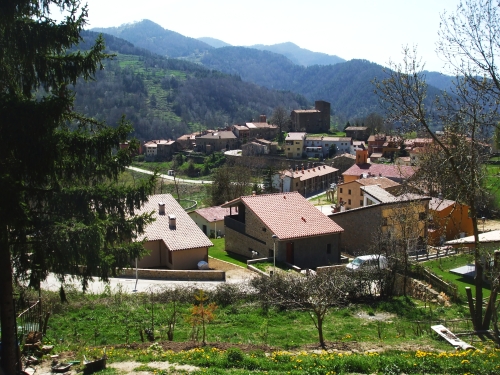
The village of Vallfogona del Ripollès, seen from the road above it
I wrote at length about Vallfogona in my book, and as far as its early history goes it is possible that no-one knows more than I do about it. Unlikely, I hope, but possible; I know of no-one else who’s studied the area, which was a reason why I looked at it. The other is that it’s immediately south of the church, nunnery as was, canonry, monastery and canonry again as was in between those states, of Sant Joan de les Abadesses, and Abbess Emma of that there establishment made sufficient inroads on the area that we see quite a lot of through the window of her transaction charters for the area. For a while she had land scattered all through it, especially in a couple of settlements called la Vinya and Arigo, the latter named for its founder and now just a farmstead called el Rauric just down the road from the main modern village, Vallfogona.1
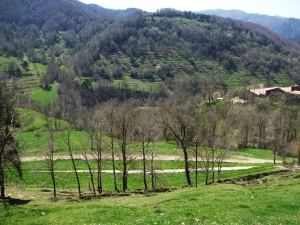
I'm pretty sure this is el Rauric, but if a knowledgeable local wants to set me right I shan't disagree; signs were hard to find
She probably also built the first church there, which was actually at Arigo, I think, though the documents don’t actually say, they just call it ‘the church’, ipsa ecclesia. But it was close to Arigo, at least, and el Rauric is now very close to the newer church, Sant Julià, whose precursor Emma’s successor Abbess Ranló put up in time for it to be consecrated in 960.2. The current building preserves none of it, we think, but it’s hard to tell, as the building is firstly in danger of collapse and secondly has been rather messed about over the years…
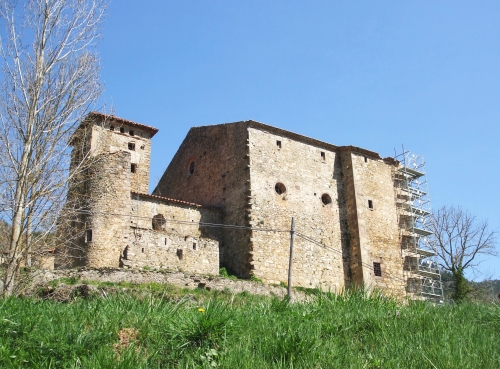
Sant Julià de Vallfogona
More beneath the cut…
And if that wasn’t evidence enough of multiple phases of construction, look at where the chancel here joins the nave and tell me something weird hasn’t happened.
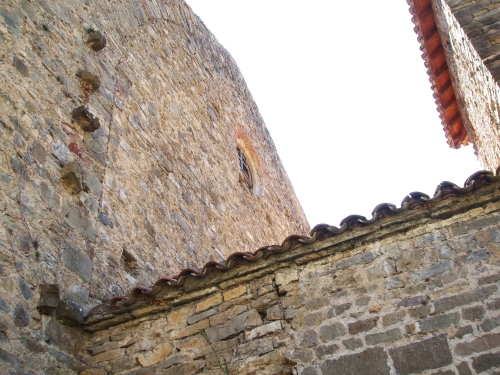
Junction of chancel and nave of Sant Julià de Vallfogona
What this turns out to be, now that I’ve looked it up, is what you get when a twelfth-century rebuild of Ranló’s church is found insufficient because of the growing population of the valley and so is rebuilt in 1756… except only partially because the project runs out of money so they had to keep some of the old structure.3 I’m guessing that would be the odd little chancel, behind the looming and only-part-present westwork, presumably once having joined up with the ghost nave seen above. The old church must have been oddly narrow and tall, unless there were aisles to it we can’t now see.
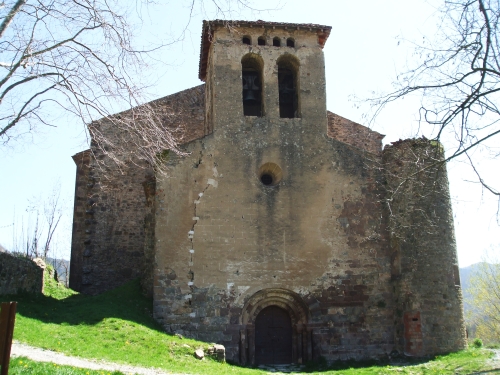
West-work, tower and part of another tower at Sant Julià de Vallfogona
Anyway. The state of the church causes other problems too. There’s supposed to be a walking route right through this rather lovely valley, from Ripoll to Ridaura, and if you come in as I did by train to Ripoll and then on the hourly bus into the village, it is well signposted. Indeed it goes straight along the old Camí Ral up to the church…4
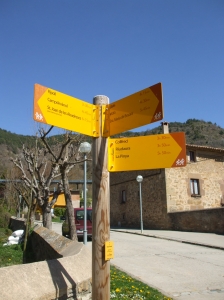 Signposts for the hiking routes from Vallfogona |
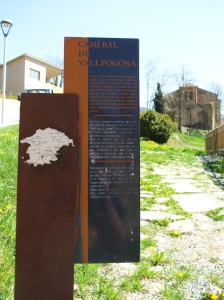 Tourist signpost noting the Camí Ral in front of Sant Julià de Vallfogona |
And then it stops, because the area around the church is fenced off and it’s not at all clear where the route goes on from there. All private land; very familiar. Asking for advice, I was told that if I went up to the road it was only about twenty minutes’ walk up to the end of the valley, and I wanted to get there because there is a story of dispute and deceit connected with it and I wanted to see what the fight had been over.
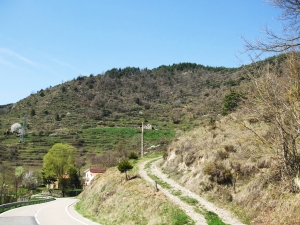
The Serra de Vallfogona, with Sant Joan somewhere beyond it, viewed from the road through the valley
Let us skip lightly over the heat, the lack of easy walkway while high-speed cars and motorbikes did exciting hairpins round the mountain road’s corners, the exactly zero number of those who were interested in picking up hitch-hikers and also, more sadly, the innumerable little lizards, because they were always gone into a hole far quicker than I could get a camera over them. Let us merely say, an hour might be more like it. But I got there. And there’s a little car-park and an optimistic finger-post there too and nothing further anywhere.
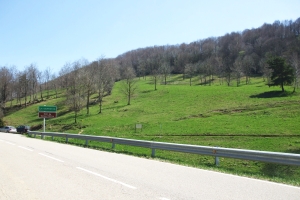
Coll de Canes, the eastern end of Vallfogona
The farmers have, I’m guessing, taken the opportunity of the blocked route end at the church to quietly remove all the route markers beyond it. These markers do exist, on other routes. Indeed, once I had walked back down into town, another hour in the sun being ignored by motorists, and managed to scrounge a sandwich and a Coke from the single café before it closed for the late afternoon, I set out the other way, because there had been two timetables for the bus available on the web and it turned out that the one on which there was no bus home was the correct one that day. So, OK, I’ve walked two hours, what’s two hours more, right? And actually at first things did seem more propitious. The route was clearly marked, in terms anyone could follow:
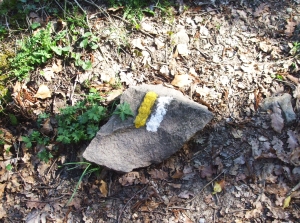 Go this way! |
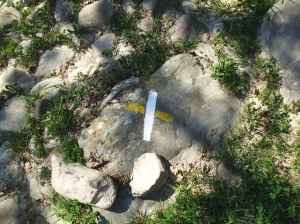 Don't go this way! |
… and I also had some very clear directions for when the signs seemed to fail, which almost always meant that I had simply not looked around thoroughly enough. This system was put in place by careful people. And it goes past some rather pretty things, not least a long time along the river, which is lovely.
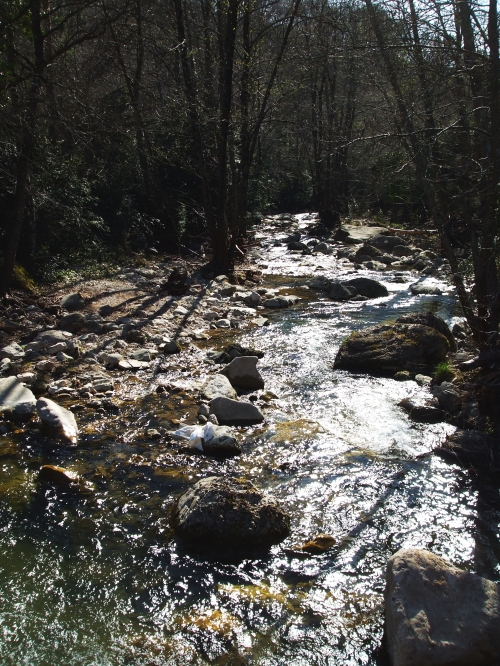
Riera de Vallfogona
And that itself is crossed by this rather wonderful Romanesque bridge, still there and no longer on the public route. What would Guifré the Hairy have said? Ah well.
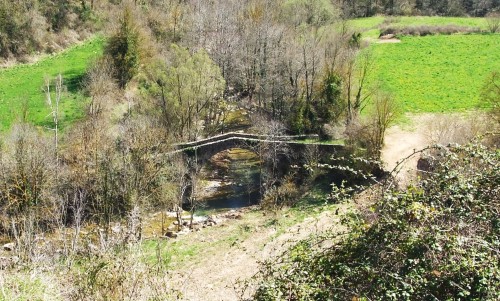
Romanesque bridge over the Riera de Vallfogona
But you may be able to tell from the light in that river picture that this went on a while. That was basically down, again, to what I think was farmer sabotage. In particular there was one large field where my guide said that the markers were on every few trees through the wood. But there were no trees there any more… Rather more obviously hostile was the clearly marked path over which one farmer had neatly pegged the electric fence that kept in his bull. This turned out not to be switched on, and the bull to be basically unbothered by me gingerly stepping through this corner of his enclosure, but it took more courage then I was expecting to need for a day’s tourism on public footpaths. Things like this, and an area where the route simply disappeared and I had to guess, left me tired, walking for hours and worrying that I would be in the dark before I had found my way back to Ripoll, so when I came close to the road again I hauled up to it and walked down that instead, not hoping for a lift any more but at least fairly sure that however far it now was I couldn’t get lost. And in fact at that point my luck changed and the third car past slowed and rescued me, and it turned out to contain a well-mannered young man with a shaved head and a band hoodie who spoke good English from some years spent in California and who basically got me back to the real town and my route home, and proved once more that there are no friends like the international league of black-clad deviants.5 So this was not a particularly good way to spend a day, scenery despite, because other than him and one waitress the locals were sniffy and unsympathetic and the local farmers had worked quite hard to keep the tourists out. At least I did accidentally happen on la Vinya too, though I’m still not sure quite what I found…
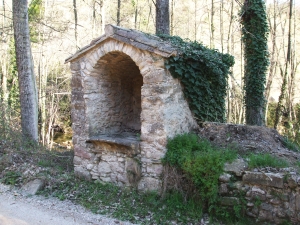
A niche at the roadside in la Vinya de Vallfogona
When I got back to Vic I was too knackered to consider anything serious and decided instead to try and find a genuinely good dinner, which I did at an oddly-decorated but wonderful little restaurant called el Rebost del Canon. I recommend it; they made me feel a great deal better about things, not least because even their cheapest wine was really far better than I’d ever hope to get eating out in England at that level. So if you’re there, try it, do. But this is a glum way to end the post, so instead let me tell you briefly about the dispute over Coll de Canes.
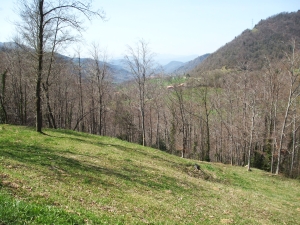
Vallfogona's east end viewed from Coll de Canes
What you can see here, basically as far as you can see in the middle, up to the second line of buildings, all used to be one estate that more or less closes off the valley, and this used to belong to a fellow called Eldoard. In 918 he gave it all to Sant Joan, and the bounds for it that he described then can still more or less be traced today as they’re basically rock ridges and rivers.
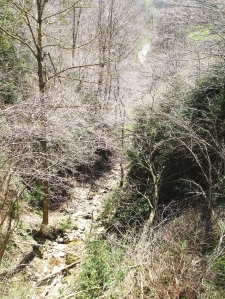
Riu d'Arçamala, in Vallfogona, or at least it would be in the rainy season, the western boundary of Eldoard's holding
Now there was also a chap called Guimarà, married to a woman called Bonita, and they had a falling-out with Abbess Emma. We’re very lucky to be able to show this, because ordinarily ceasing to deal with the abbey would have denied people access to the record. But they did it quite big-time, to the extent that shortly after Emma had taken them to court in 917, and they’d lost, both of them dropped out of Sant Joan patronage entirely. We subsequently see them instead selling a huge chunk of land to Count Sunyer, Abbess Emma’s younger brother, whom as we know had ambitions on Sant Joan’s independence, in 931. And what did they sell? The rocks and rivers make it clear: they sold Eldoard’s gift to Sant Joan, which they had somehow got hold of.
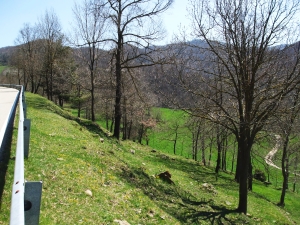
The east end of Vallfogona, viewed from just east of halfway up
In the book I hypothesize that what had happened is that Bonita was Eldoard’s daughter, and the problem that caused her and Guimarà to lose Emma’s favour was not the case that they lost, but one that they won challenging Eldoard’s gift, but we can’t be sure.6 Anyway, this was the start of a big thing because subsequently Sunyer managed to get hold of the rest of Vallfogona too, and this seems to have wiped out whatever rights Sant Joan might have held there; there is no sign of their property there in later acquisitions in the area.8 Sunyer’s son Borrell (for it is he) eventually sold or gave quite a lot of this land to the deacon Miró, later Count of Besalú, I’m thinking probably after he lost a war to Miró and brothers, and much later Miró seems to have given at least this end of it it to one Sendevad, who then gave it to Sant Joan. And one misfiled and damaged document shows us Sendevad’s mother… and she was called Bonita.9 So it all links up and we may have three generations all giving this land to someone and then clawing it back or vice versa. On such things could livelihoods and status hang, I guess. I’ll write more about what status here hung on eventually, but this has already been quite long enough. In my defence, so was the day it recounts… Oh yes, and just one more thing: in my period, this was a pioneer area: Arigo founded his new village himself, on unsettled land. Even now, this opportunity still just about exists:
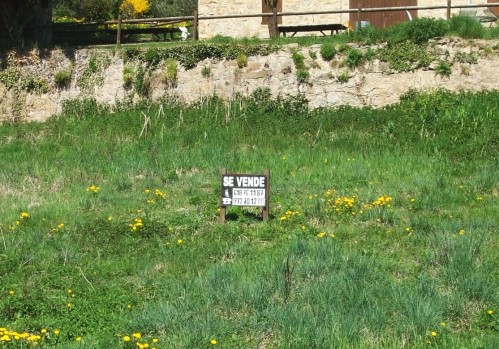
Land for sale in Vallfogona del Ripollès
But trust me on this, you’re going to need a car.
1. All the detail, and references to the documents—given there’s a hundred and fifty or so I shan’t list them here—can be found in J. Jarrett,Rulers and Ruled in Frontier Catalonia, 880-1010: pathways of power (London 2010), pp. 30-64.
2. All right, just one: that can be found in Ramon Ordeig i Mata (ed.), Catalunya Carolíngia IV: els comtats d’Osona i Manresa, Memòries de la Secció Històrico-arqueolòica LIII (Barcelona 1999), doc. no. 858, which is also printed in several other places but most notably in Federico Udina Martorell, El Archivo Condal de Barcelona en los Siglos IX-X: estudio crítico de sus fondos, Textos XVIII, Publicaciones de la Sección de Barcelona no. 15 (Madrid 1951), doc. no. 128. I discuss Arigo and its church specifically in Rulers and Ruled, pp. 32-35.
3. This detail from M. Anglada i Bayés, Antoni Pladevall i Font, M. Lluïsa Cases, Jordi Vigué i Viñas, Joan-Albert Adell i Gisbert & N. Peirís i Pujolar, “Sant Julià de Vallfogona” in Pladevall (ed.), Catalunya Romànica X: el Ripollès, ed. Vigué (Barcelona 1987), pp. 445-448.
4. On the Camí Ral, see either that signpost (the actual image is quite large) or Jordi Bolòs i Masclans, “Camí de Vallfogona”, ibid. pp. 449-450.
5. Seriously, though. I owe a lot to the generosity of people who only knew about me that I shared some of their music taste. Membership of this group is important to me and is why I don’t plan cutting my hair in any future I can currently foresee. (The hair and band shirt may of course have been why everyone else didn’t pick me up, but I choose to ignore that possibility.)
6. The whole episode recounted in Jarrett, Rulers and Ruled, pp. 50-51 (Eldoard’s gift) & 53-57 (Guimarà and Bonita).
7. Ibid., pp. 64-66.
8. Ibid., pp. 66-67 for Sendevad and his gift to Sant Joan; the document identifying Bonita as his mother, however, which is Ordeig, Catalunya Carolíngia IV, doc. no. 699, I didn’t find until too late for it to go in the book, so this is fresh research, a kind of bonus extra for the blog readers, or else a humiliating correction, whichever you’d rather. Weirdly, though, this is not the only document featuring this family that got so misfiled, another is ibid. no. 507. Both are very hard to read and I like to wonder if this wasn’t because Guimarà and Bonita managed to spill something on their charter-bag or got flooded one year or something; something obviously happened to just these documents and it makes sense that it would have done so when they were still outside the archive. A human touch, perhaps.


I do wish I’d been able to travel more, beyond just Barcelona. Curse my budgetary and time limitations!
Well, you know, it took me long enough! Though most of my constraints were more domestic.
It may not have made you feel particularly welcome or cheerful, Jon, but don’t you think there’s something deliciously medieval in the approach to land holding here? By which I specifically mean the farmers pushing the boundaries of ownership by asserting what we in later English contexts know as seisin, and simply daring anyone to test them on it. Or to put it more colloquially, “posession is 9/10 of the law”! Even removing the path markers seems to have its medieval echoes – perhaps, I admit, somewhat encouraged by the romance of your images. But seriously, if the physical markers of boundaries are missing, who’s to say there was a path here (or that this was the limit of your lordship, etc)? If we’re relying on memory to establish ‘space’ of any kind, that’s manipulable over time, even if it rests in a wider community than just one farming family, and perhaps most especially when practice and use have successfully been altered. Then it’s my (and my supporters’) word(s) against yours (and yours’) if it should come to it… except for that pesky written record, i.e. your guidebook!
I can imagine quite similar actions provoking the kinds of disputes you’ve studied so closely… Does it give your sore feet *some* comfort to have lived it?
Well, not for nothing is Jeffrey Bowman’s book on legal disputes here called Shifting Landmarks, so you have a point there. It hadn’t struck me especially because of the signposts and electric fence, not very medieval intrusions on an otherwise quite agricultural landscape—seriously, there are old terraces on almost every hill—and I suppose I also identify as a heritage management person in some sense what with the museum `career’. But I have to admit that I think that the guy who cleared the marked trees was clearing trees, more than deliberately the markers. That’s also fairly medieval I suppose! Not quite aprisio but then he (presumably!) owned the land already. All the same, yes, next time the Generalitat or the Ajuntament send someone along to check the path I imagine there’ll be a fairly old-fashioned argument…
To follow up on Kath’s comment, a big deal around here is abandoned railroads. When a railroad is abandoned a group is allowed to do something called “railbanking” which maintains the railbed which is then frequently developed into a hiking or biking trail. When farmers catch a whiff that this might happen, quite frequently the bulldozer comes out and the railbed is destroyed, whether they have the right to do so or not. Once the bed is destroyed it often becomes prohibitively expensive for a nonprofit to restore so they don’t bother trying to claim it.
I’ve been surprised (at first, on reflection, less so) at how similar disputes over land have stayed over the past 1500 years. Today we see the same sort of things brought up – who’s supposed to maintain the fence row, fertility, drainage, maintenance of fences, damage caused by animals, flooding and casual water and so on. I honestly don’t think I’d be surprised if I heard about a court case which involved the two parties bringing a dozen or so oathfriends each. This land stuff has stayed remarkably consistent over time, and these days, in this area, over half of the land is farmed by renters.
Thanks for sharing a beautiful place to visit. but its sad for me that i can’t visit this place.
Jonathan, this is a wonderful post! I’m [abroad] right now, but nothing nearly as adventurous (unless you count the many people in [this city] ready to separate me from my money by means legal or otherwise). But next time I need a hiking partner who doesn’t blanch at me saying, “Hey, what do you think we’d see if we ducked under that and climbed up on top of that thing?”, I know who to call.
Even if you are a black-clad deviant. ;-)
[JAJ: redacted to remove identifying information]
We could be expert guides for each other! It’s perfect: you know how to avoid getting ripped off in Barcelona, I can follow a trail and if necessary call local relatives and beg for help, it’s a match made in heaven! Except in as far as I bet our calendars make it completely impossible. But in that heat, I think the black is negotiable…
Pingback: Contagions Round-up 11: E. coli, Excavation Reports, and Early Medieval Continuity « Contagions
Thanks for sharing a blog full of beauty of history.”Coll de Canes, the eastern end of Vallfogona” is such an amazing place, I so wanna go there.
Pingback: In Marca Hispanica XIII: more stones than parchment I (Santa Maria de Ripoll) « A Corner of Tenth-Century Europe
Pingback: In Marca Hispanica XIV: l’Esquerda, city of helpful archæologists « A Corner of Tenth-Century Europe
Pingback: Cool Stuff on Other Blogs II « Medieval History Geek
Pingback: Seminar CLXXII: roads to nowhere? | A Corner of Tenth-Century Europe
Pingback: Nearest neighbours in the pre-Catalan foothills | A Corner of Tenth-Century Europe
Pingback: The kind of maths we should not do | A Corner of Tenth-Century Europe